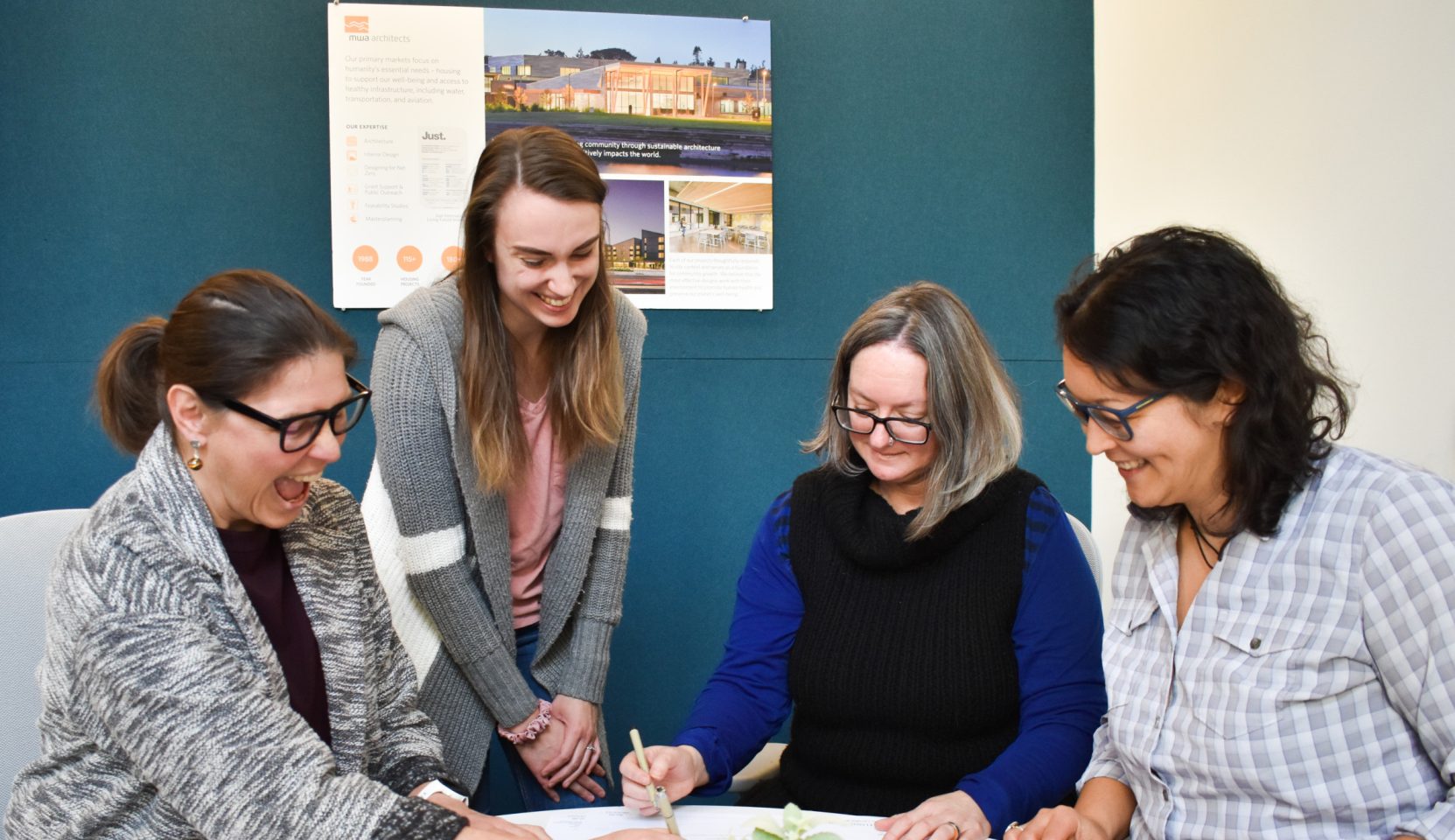
With one of MWA’s core values being responsibility, we always seek to do the right thing. We believe that designing for Net Zero energy is the responsible thing to do, and joining the 2030 commitment was MWA’s pledge to move towards a Net Zero future. The Energy Trust of Oregon has supported us in this effort by awarding us grants for the following opportunities:
- MWA Principal and Director of Sustainability Jean Root’s Net Zero Fellowship
- Celia Crawford’s Net Zero Emerging Leaders Internship
Today, we are discussing the latter.
Celia joined MWA’s Sustainability Studio as the Net Zero Emerging Leaders Intern because she is curious about the ways in which energy conservation shapes design. Working with the Sustainability Studio, Celia has explored the ins and outs of energy conservation while supporting MWA in meeting the requirements of the 2030 commitment.
Excited to share what Celia has been working on during her time with us, we sat down with her to hear what she values about this opportunity. Her thoughts are recorded below.

Why is the AIA 2030 Commitment important to you?
I believe we all have a part to play in conserving our planet. Humanity takes a toll on the environment with our modern way of life, and I think it is important to recognize that some of our practices have damaging consequences. We’ve come a long way and learned a lot from older industrial systems, but there is still a ways to go, and setting real, tangible goals, as the 2030 Commitment does, is an important step in achieving a healthier, more sustainable environment.
Has anything surprised you about the energy usage that you have been tracking?
Not necessarily surprising, but interesting in seeing energy usage quantified, especially when renewables are involved. On projects with solar feasibility, for example, seeing how drastically it can bring down the predicted usage, and sometimes even cancel it out is very cool and solidifies my confidence in renewable energy.
“Celia has been a team player from day one. She seeks out resources and sees challenges through to a successful end. I am so happy to be working with her. Without Celia we would not have been able to be as complete and thorough with our 2030 commitment. Her attention to detail has given us a place to start talking about our next generation of sustainable reporting: carbon.”
– Jean von Bargen Root
What have you learned so far?
It has been amazing to see exactly how much renewables offset energy usage. I’ve never had any reason to doubt the efficiency of renewable energy, but seeing the raw numbers on how much energy it could produce and counter the energy we would normally consume is fascinating. And solar is just one option I’ve been able to visualize. Of course, it is an additional cost upfront, but I think it’s clear that the production of energy and long-term savings easily pay for itself.
I also learned that the process of energy modeling includes the 3D model itself, but also all the components that make up the building. This accounts for building materials and the values of those materials. Learning about R-values, U-factors, and SHGC (solar heat gain coefficient) has been a big part of recognizing and optimizing how energy is used as a result of material choices, and going forward will be a big help working on other projects.
“With Celia coming on board she was able to energy model a lot more projects this year than we were able to do in previous years. This gives us an overall sense of how different projects from different studios will be using energy and helps us make informed decisions in design.”
– Shradhan Shrivastav
From your perspective, what do you see as MWA’s next steps toward the 2030 Commitment?
I think that encouraging and promoting renewable energy solutions at any opportunity is the biggest step. Using established projects with renewables in place can be a good example to our clients of how these solutions are in the best interest of projects and their occupants.
Which MWA project is most inspiring in terms of sustainable design?
As of right now, I would say the Bull Run Administration Building, mostly because the renewable energy data is most up to date. Seeing how solar energy produces almost 100% of the energy needed is truly inspiring, because it shows just how well renewable energy can work.

With a background in interior design, are there any sustainable design solutions that you are now inspired to incorporate into interiors?
Sustainable solutions begin with architecture and building performance. Once you look at the interior, the focus is on the occupant’s experience and how they use the space. Materials is the most obvious place to start. From flooring, to paint, to countertops and anything else, there are so many sustainable options now, and many companies are getting on board to create more eco-friendly products and recyclable solutions. Beyond the physical materials, how someone feels in the space can be enhanced by incorporating natural daylighting, good ventilation (eco-friendly materials can also enhance air quality), and especially bringing in elements of nature and greenery.
